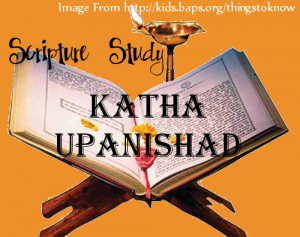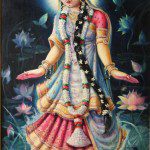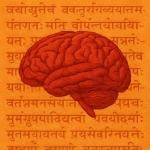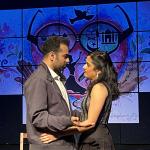We are doing a scripture study together: reading along through some scriptures and discussing the passages. We are reading one of my favorite upanishads: The Katha. This is the story of a boy who chatted with the God of death.
http://www.angelfire.com/electronic/awakening101/upani_katha.html
10
When the five instruments of knowledge stand still, together with the mind and when the intellect does not move, that is called the Supreme State.
11
This, the firm Control of the senses, is what is called yoga. One must then be vigilant; for yoga can be both beneficial and injurious.
12
Atman cannot be attained by speech, by the mind, or by the eye. How can It be realised in any other way than by the affirmation of him who says: “He is”?
13
He is to be realised first as Existence limited by upadhis and then in His true transcendental nature. Of these two aspects, Atman realised as Existence leads the knower to the realisation of His true nature.
14
When all the desires that dwell in the heart fall away, then the mortal becomes immortal and here attains Brahman.
15
When all the ties of the heart are severed here on earth, then the mortal becomes immortal. This much alone is the teaching.
16
There are one hundred and one arteries of the heart, one of which pierces the crown of the head. Going upward by it, a man at death attains immortality. But when his prana passes out by other arteries, going in different directions, then he is reborn in the world.
17
The Purusha, not larger than a thumb, the inner Self, always dwells in the hearts of men. Let a man separate Him from his body with steadiness, as one separates the tender stalk from a blade of grass. Let him know that Self as the Bright, as the Immortal—yea, as the Bright, as the Immortal.
18
Having received this wisdom taught by the King of Death and the entire process of yoga, Nachiketa became free from impurities and death and attained Brahman. Thus it will be also with any other who knows, in this manner, the inmost Self.
End of Katha Upanishad
http://www.vedarahasya.net/katha-6.htm
That state in which the five sense organs (the action organs are referred to as karma-indriya and the sense organs are referred to as gnaana-indriya) remain united with the mind, and where the intuition or the brain remains idle or blank without any thought is the ineffable, supreme state of bliss.
That state at which the sense organs are devoid of any activity (constant practice of inactivity of the sense organs) is the Yoga state. The wise one who has attained that state is undistracted and remains free from the clutches of the sense organs and their compelling desires – since yoga is essentially of the nature of arising and fading away.
The Atma cannot be reached through speech, mind and the (naked) eyes. How else can it be comprehended except from the words of the wise sages who have experienced it and affirm that ‘it exists’?
Out of the two thoughts viz., ‘it can be seen’ and ‘it cannot be seen’, one who firmly believes in the former with concrete will power (and with the idea of it being in a definite form), will be able to realize the ultimate truth (of its no-form nature) which is beyond any sort of forms and speech and thought.
As soon as all the desires hidden in one’s heart are destroyed, he transcends from mortality to immortality. He enjoys the Supreme Bliss.
As soon as all the knots in one’s heart are untied while being here in this world, he transcends from mortality to immortality. This is the decision of the teaching.
There are a hundred and one nerves attached unto the heart. Out of those, one runs upward to the head. The Jiva attains immortality by going up through that nerve. All other nerves take him back only to the cycle of births and deaths.
(It is said that the Jiva of sages and other wise men goes out of the body through the head – called as the kapaala moksha and also that after their death, a hole can be felt in their skull at the top most center. Probably, this is what is indicated in the teaching).
The Atma, of the size of one’s thumb, residing in the body is present always and at all times in the heart of the people. As the minute weeds are removed from the grass, so should the Atma be distinguished and segregated from the body by the use of clear intelligence and steady mind. He is the pure one and the immortal, eternal one.
Naciketas, having gained this knowledge (of the Self) and the other rules of Yoga discipline directly from Yama, attained Brahman or salvation by removing himself of all emotions and desires and attained immortality. Anyone else who thus understands these principles about the Self shall also attain immortality in as much the same way.
Commentary (Swami Krishnananda)
…He is not seen by the senses, but felt in the mind as sattva. The senses cannot give us this feeling; they are too dissipated. So try to meditate in the deepest recesses of your heart.
…Yoga is meditation, finally, and every other technique is an accessory to it. What is meditation? It is a joint activity of the senses, mind and intellect. Three conditions are stated: “When the five senses stand together with the mind, the mind is still and the intellect is also still—which means to say that the senses, the mind and intellect should come together—that state is yoga, the highest state.” A steady repose of the senses is yoga; steadfastness of the senses is yoga. This is a simple definition. It may appear to be simple, but one should be very careful here because you may be in yoga or you may not be in yoga. You may fall if your balance is not maintained.
…But in yoga these different activities are integrated, brought together for a single purpose. All five senses should be engaged in the same activity. In Patanjali’s Yoga Sutra, pratyahara is defined as non-difference of the sense-power from the mental-power.
… Looking is mere indeterminate perception, which is harmless. But seeing is appreciation of values. This is called bondage; this is jiva-srishti. Mere sensation in an indeterminate, general psychological sense is not what binds. Selfish concern it is that binds. Do you have such an interest in a thing? Then you should be careful.
You may see or touch an object without being attached to it, because sensation not related to emotion is different from emotional sensation. You feel a joy in touching a thing; by seeing a thing, you are either pleased or displeased. But by looking at something, if there is no such emotional reaction, you will not be bound. So tying a piece of cloth over the mouth and such other austerities is not control. If there is a steadfastness of the internal senses, it is yoga.
…You cannot be in yoga always. Be careful. “Just because you concentrated well one day does not mean that you have risen to the highest. Yoga comes and goes.” Never think you are well-off in yoga. Spiritual pride is the worst thing.
…Is Reality positive or negative, is a crucial question. If you negate everything, if you deny Brahman, then you deny yourself, because Brahman is only another name for your own Reality. But in your effort to think of Reality, what attitude are you to adopt? In mantra twelve, the Kathopanishad says that no attempt is going to succeed easily. You cannot think It with your mind. How then can you have an idea about It? You cannot see It with your eyes, nor explain Its characteristics. Mind, speech and all senses return baffled when they attempt to know Reality.
“Nevertheless,” says Yama, “finally I might say that you should regard it as ‘being’, because what else could be said about It?” So being seems to be the attitude recommended here. Brahman is not the negation of all things, because even if It is that, It implies the existence of something: the final remainder, pursued through the process of neti-neti, is Reality. The doctrine of negation also implies your own self. What then remains? Not nothing, because that which has denied or set aside everything, that which has done the act of negation remains, and thus we come to a kind of ‘being’, and not ‘non-being’.
…All our searching in objects for this Reality is only an experimentation; and the answer is always negative because It is not there—outside you—in objects. You carry It with you always. It is the greatest negation, objectively; but subjectively, It is the Supreme Being or Absolute Existence which is the negation of everything external, of everything outside Brahman.
…Consciousness is compared to the purusha of the size of a thumb. This is for the sake of concentration and meditation. In relation to His entry into various beings, this universal Self appears to be of the size of a thumb; and He is in all.
This consciousness is to be separated from the body, like separating the pith of the munja grass or the plantain stem from its outer covering, as is done in various rituals; the covering is to be removed. Likewise, the body is to be isolated from consciousness; and this consciousness is to be concentrated on itself; then it becomes immortal. “Know this to be the Pure, Immortal—know this to be the Pure, Immortal.” This is the teaching of the Upanishad.
My Thoughts
I think the part about the Atman being the size of a thumb or no larger than a thumb is metaphorical. As the Swami says, it gives your mind somewhere to rest in meditation. In reality all is Brahman.
There’s some very valuable insight here about the process of meditation. I’m also glad the Swami went into some detail about the process of negating. The “neti-neti” he refers to is a practice of saying “not this, not this” to things/objects in this world. It is a reminder that there is something more real behind it all. When you eliminate everything that is not real, what remains is the Universal Self/Brahman.
I hope you can see why I love this Upanishad. It’s poetry is beautiful and just reading it with a clear mind, not even trying to understand it, brings me to a sattvic state.
Starting next week I’ll begin sharing and talking about the Gita.
Hindi NaNoWriMo
As I said in October, this month is National Novel Writing Month and I decided to challenge myself to write a story in Hindi. It will not be 50,000 words, but I’ll see how far I can get. If you know Hindi, please do give me corrections. It helps a lot if you’re able to explain the reason for your correction (such as: “no one would say it that way”, “that’s awkward”, “the endings don’t match”, “the tense is wrong” Things like that). Okay, here we go!
एक बार दो तितलियों पेड़ में बैठ रहे थे I एक तितली नारंगी और काली थी I दूसरा पीला था I वे एक दूसरे को के साथ नाच रहे थे I वे आसमान में ऊंची उड़ I लड़का तितली अपने पंख फ्लैप “मुझसे तुमसे प्यार है” कहती I लेकिन द्वेषी राक्षस उन्हें देखता है I












